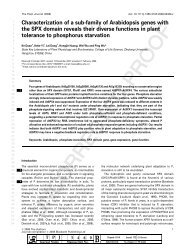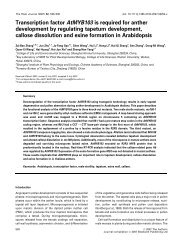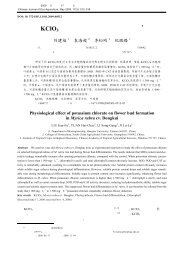Brassica campestris L. ssp. chinensis M
Brassica campestris L. ssp. chinensis M
Brassica campestris L. ssp. chinensis M
Create successful ePaper yourself
Turn your PDF publications into a flip-book with our unique Google optimized e-Paper software.
Bajh97-01A/B<br />
Actin<br />
cotyledon of the Chinese cabbage-pak-choi (Cao<br />
et al., 2000). In this study, the MS medium, with half<br />
strength of NH 4 + and supplemented with 4 mg L 1<br />
6-BA, 1 mg L 1 NAA, and 7.5 mg L 1 silver nitrate<br />
solution, was found to be optimal in obtaining a high<br />
frequency of shoot regeneration in flowering Chinese<br />
cabbage. The optimum conditions for gene transformation<br />
to flowering Chinese cabbage were estab-<br />
ARTICLE IN PRESS<br />
Functional analysis of a novel PCP gene BcMF5 449<br />
Figure 2. (A) Nucleotide sequence of BcMF5 and its deduced amino acid sequence. The shadowed region is the intron of<br />
BcMF5; the underlined amino acid is the putative signal peptide of BcMF5. (B) Alignment of the amino acid sequences of<br />
BcMF5, PCPA2, and SLR-BP. Asterisks indicate eight conservative cystine residues of PCP.<br />
m1 w1 m2 w2 m3 w3 m4 w4 m5 w5 mF wF mSi wSi mS wS mL wL<br />
Figure 3. RT-PCR results of BCMF5 in different organs of ‘Bajh97-01A/B.’ The symbols m1, m2, m3, m4, m5, mSi, mS,<br />
and mL indicate stage I flower bud (o1.0 mm), stage II flower bud (1–1.6 mm), stage III flower bud (1.6–2.2 mm), stage<br />
IV flower bud (2.2–2.8 mm), stage V flower bud (2.2–2.8 mm), open flower, germinal silique, stem, and leaf of sterile<br />
line, respectively, while w1, w2, w3, w4, w5, wF, wSi, wS, and wL indicate stage I flower bud (o1.0 mm), stage II flower<br />
bud (1–1.6 mm), stage III flower bud (1.6–2.2 mm), stage IV flower bud (2.2–2.8 mm), stage V flower bud (2.2–2.8 mm),<br />
open flower, germinal silique, stem, and leaf of fertile line, respectively. Action external control.<br />
lished as follows: 3 d for pre-culture, LBA4404 strain<br />
for A. tumefaciens, 10–15 min of infection, and 3 d<br />
for co-culture. Explants gathered after co-culturing<br />
under optimum conditions were inoculated into the<br />
regeneration medium containing 10 mg L 1 kanamycin,<br />
before the Kan R shoots were obtained (Figure 4).<br />
Afterwards, the explants were sub-cultured on the<br />
same medium every 3 weeks, before finally obtaining








